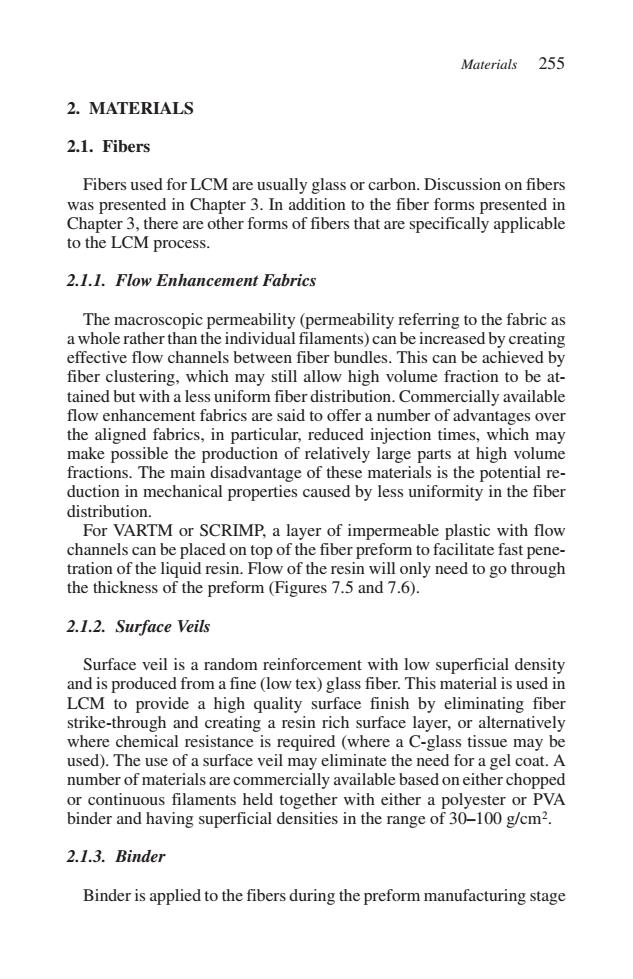正在加载图片...

Materials 255 2.MATERIALS 2.1.Fibers Fibers used for LCM are usually glass or carbon.Discussion on fibers was presented in Chapter 3.In addition to the fiber forms presented in Chapter 3,there are other forms of fibers that are specifically applicable to the LCM process. 2.1.1.Flow Enhancement Fabrics The macroscopic permeability(permeability referring to the fabric as a whole rather than the individual filaments)can be increased by creating effective flow channels between fiber bundles.This can be achieved by fiber clustering,which may still allow high volume fraction to be at- tained but with a less uniform fiber distribution.Commercially available flow enhancement fabrics are said to offer a number of advantages over the aligned fabrics,in particular,reduced injection times,which may make possible the production of relatively large parts at high volume fractions.The main disadvantage of these materials is the potential re- duction in mechanical properties caused by less uniformity in the fiber distribution. For VARTM or SCRIMP,a layer of impermeable plastic with flow channels can be placed on top of the fiber preform to facilitate fast pene- tration of the liquid resin.Flow of the resin will only need to go through the thickness of the preform (Figures 7.5 and 7.6). 2.1.2.Surface Veils Surface veil is a random reinforcement with low superficial density and is produced from a fine (low tex)glass fiber.This material is used in LCM to provide a high quality surface finish by eliminating fiber strike-through and creating a resin rich surface layer,or alternatively where chemical resistance is required (where a C-glass tissue may be used).The use of a surface veil may eliminate the need for a gel coat.A number of materials are commercially available based on either chopped or continuous filaments held together with either a polyester or PVA binder and having superficial densities in the range of 30-100 g/cm2. 2.1.3.Binder Binder is applied to the fibers during the preform manufacturing stage2. MATERIALS 2.1. Fibers Fibers used for LCM are usually glass or carbon. Discussion on fibers was presented in Chapter 3. In addition to the fiber forms presented in Chapter 3, there are other forms of fibers that are specifically applicable to the LCM process. 2.1.1. Flow Enhancement Fabrics The macroscopic permeability (permeability referring to the fabric as a whole rather than the individual filaments) can be increased by creating effective flow channels between fiber bundles. This can be achieved by fiber clustering, which may still allow high volume fraction to be attained but with a less uniform fiber distribution. Commercially available flow enhancement fabrics are said to offer a number of advantages over the aligned fabrics, in particular, reduced injection times, which may make possible the production of relatively large parts at high volume fractions. The main disadvantage of these materials is the potential reduction in mechanical properties caused by less uniformity in the fiber distribution. For VARTM or SCRIMP, a layer of impermeable plastic with flow channels can be placed on top of the fiber preform to facilitate fast penetration of the liquid resin. Flow of the resin will only need to go through the thickness of the preform (Figures 7.5 and 7.6). 2.1.2. Surface Veils Surface veil is a random reinforcement with low superficial density and is produced from a fine (low tex) glass fiber. This material is used in LCM to provide a high quality surface finish by eliminating fiber strike-through and creating a resin rich surface layer, or alternatively where chemical resistance is required (where a C-glass tissue may be used). The use of a surface veil may eliminate the need for a gel coat. A number of materials are commercially available based on either chopped or continuous filaments held together with either a polyester or PVA binder and having superficial densities in the range of 30–100 g/cm2. 2.1.3. Binder Binder is applied to the fibers during the preform manufacturing stage Materials 255